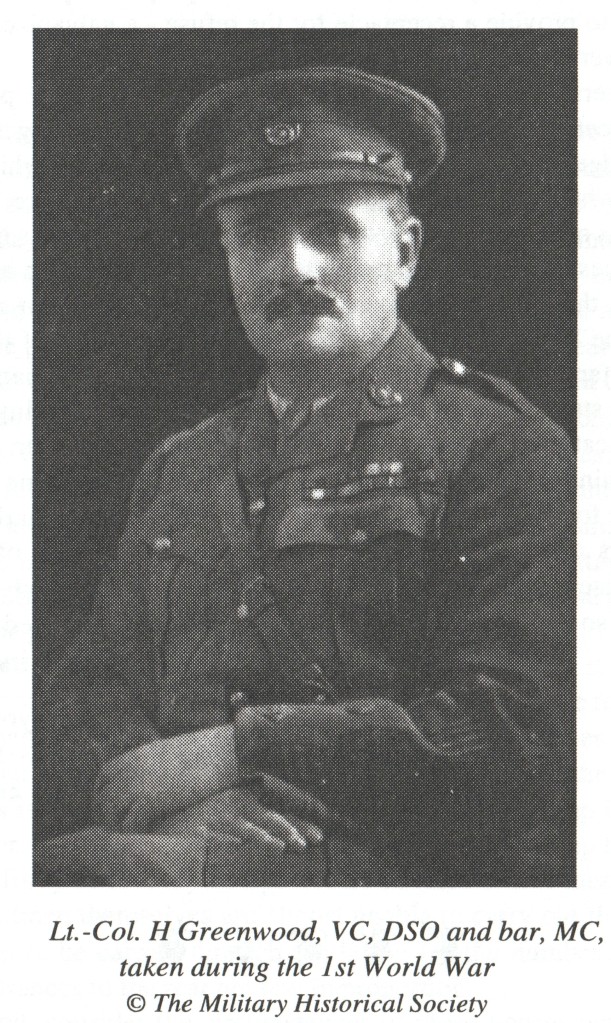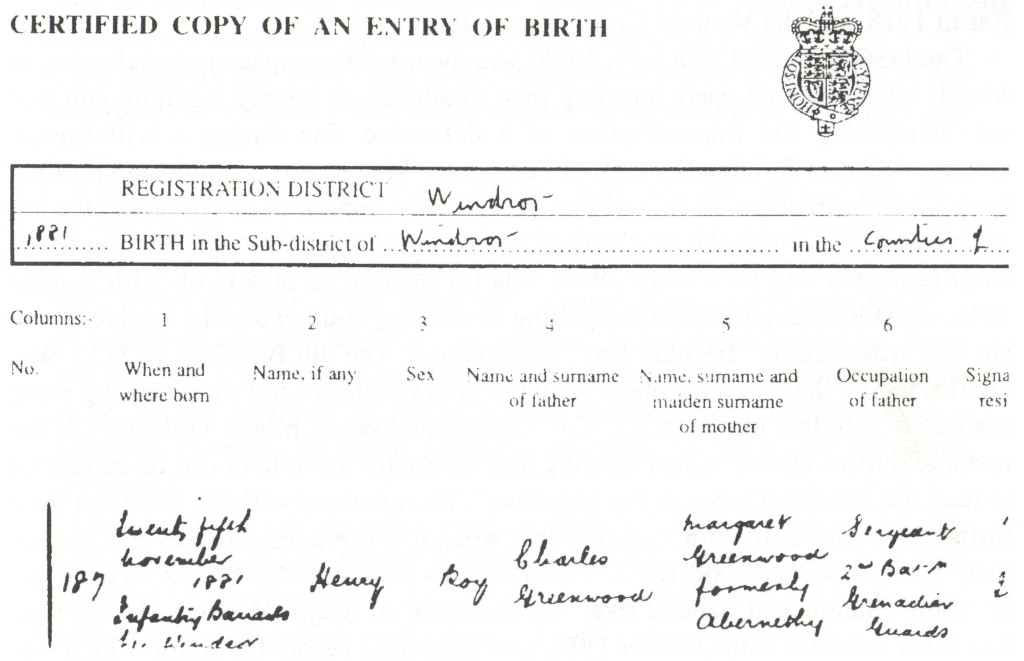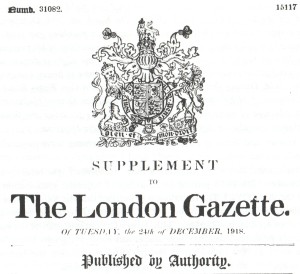Published in Windlesora 15 (1997)
© WLHG

Nearly half of all the Victoria Crosses awarded for outstanding bravery since 1856 (1,351 plus 3 bars) were won in a period of just over four years during the First World War (632 plus 2 bars). This was the bloodiest conflict ever known, and the large number of VC awards reflects the enormous sacrifices made by those who fought for King and Country. There were many brave men who performed deeds which rightly warranted the nation’s highest award ‘FOR VALOUR’.
This is the story of one such hero – Colonel Harry Greenwood VC, DSO and Bar, OBE, MC, who was born at Windsor Infantry Barracks on 25th November 1881. His mother, Margaret Abernethy, was originally from Co. Tipperary, Ireland.
His father, Charles Greenwood, was sergeant in the 2nd Battalion, Grenadier Guards. The Regiment was stationed at Windsor at the time and Sgt. Greenwood and his wife were living in the married quarters within the barracks.
Windsor Infantry Barracks were built in 1797, with additions being made throughout the Victorian era. Windsor had been a garrison town even before the two barracks were built – previously it had been customary to billet soldiers in private homes and inns throughout the town. In 1889 Windsor Infantry Barracks were renamed Victoria Barracks, although they continued to be occupied by infantry regiments. Demolition of the old barracks (parts of which were said to be the oldest in the country) began in 1982 – starting with the married quarters – and continued over the next seven years. Rebuilding work commenced in 1989 and was completed in 1993.
Greenwood’s birth certificate records his first name as Henry, although he was known as Harry throughout his life, and Harry is the name on his VC citation and also his death certificate.
When the South African War – popularly known as the Boer War – broke out in 1899, Greenwood decided to enlist. Aged 17, he joined the City (of London) Imperial Volunteers (CIV). This force was raised from all the volunteer regiments of the capital and Harry served throughout the regiment’s time in South Africa – January to October 1900. The volunteers served alongside regular troops and were frequently in the thick of the action. Although the South African War did not end until May 1902, the CIV and some other troops were returned home early on the orders of Lord Roberts, the Commander-in-Chief. At the end of October 1900 Greenwood took part in the parade from Paddington Station to St Paul’s Cathedral for a special service and then on to a reception by the Lord Mayor at the Guildhall.

Like many other volunteers who had served in South Africa, Greenwood decided that there was a future for him in that country and returned to join the South African Constabulary, a yeomanry force established after the war. He joined Sir Robert Williams & Co. in 1901 and worked in this and other associated companies (which had substantial mining interest in Africa) as private secretary to Sir Robert Williams until 1914.
Greenwood’s interest in the army continued after his return to England and he was a member of the Territorial Army from its inception in 1908 (when the new force absorbed and expanded upon the militia, yeomanry and volunteer units) until 1914. He served with the King’s Royal Rifle Corps. In 1909 he married Helena Anderson from Newcastle and they later had two daughters.
At the outbreak of The Great War, Harry Greenwood joined the Regular Army via the Reserve of Officers. He was attached to the 9th (Service) Battalion, the King’s Own Yorkshire Light Infantry (KOYLI) as a Captain, and transferred with his regiment to France in September 1915. Prior to leaving for the front, the battalion had been in temporary billets at Maidenhead and was inspected by HM the King when the troops were passing through Windsor.
They soon saw action, and Harry Greenwood was wounded on three occasions during the course of the war. He was also mentioned in despatches three times, awarded the Military Cross in 1916, the Distinguished Service Order (DSO) and Bar in 1918, and the Victoria Cross, also in 1918.
The DSO (gazetted 26th July, 1918) was awarded for a spectacular advance, in March 1918, through early morning mist to silence an enemy machine gun that was hampering the improvisation of a defensive line during a withdrawal. Greenwood, now holding the rank of Temporary Major, also captured and brought back several prisoners. In July of that year, he was appointed to command the 9th Battalion KOYLI with the new rank of Acting Lieutenant-Colonel. The Bar to the DSO (gazetted 2nd December 1918) was for leading an attack, on 24th August 1918, on a German position and repelling two enemy counter attacks until relieved. He was wounded by “friendly fire” in the action. The 9th Battalion KOYLI War Diaries record that “several shells from our heavy batteries fell short causing some casualties amongst our men, Lt. Col. Greenwood being blown violently off his feet and thrown against a post injuring him internally. In spite of this he continued to lead the Battalion towards the objective’. He remained with his battalion for a further five days until 29th August 1918, when it was recorded in the War Diaries that “Lt. Col. Greenwood DSO, MC owing to wound and sickness went to the Dressing Station and handed over the Battalion to Major Walsh”. He returned from sick leave on 15th October 1918, just eight days before the action which was to earn him the Victoria Cross.

The London Gazette, in which all Victoria Cross awards are officially announced, recorded in its supplement of 26th December 1918:
His Majesty the KING has been graciously pleased to approve of the award of the Victoria Cross to the undermentioned Officers, N.C.O.s and Men:-
T./Maj. (A./Lt.-Col.) Harry Greenwood, D.S.O., M.C., 9th Bn., K.O.Yorks.L.I.
For most conspicuous bravery, devotion to duty and fine leadership on the 23/24th October, 1918. When the advance of his battalion on the 23rd October was checked and many casualties caused by an enemy machine-gun post, Lt.-Col. Greenwood single-handed rushed the post and killed the crew. At the entrance to the village of Ovillers, accompanied by two battalion runners, he again rushed a machine-gun post and killed the occupants.
On reaching the objective west of Duke’s Wood his command was almost surrounded by hostile machine-gun posts, and the enemy at once attacked his isolated force. The attack was repulsed, and, led by Lt.-Col. Greenwood, his troops swept forward and captured the last objective, with 150 prisoners, eight machine guns and one field gun. During the attack on the Green Line, south of Poix Du Nord, on 24th October, he again displayed the greatest gallantry in rushing a machine gun post and he showed conspicuously good leadership in the handling of his command in the face of heavy fire. He inspired his men in the highest degree with the result that the objective was captured and, in spite of heavy casualties, the line held. During the further advance on Grand Gay Farm Road, on the afternoon of 24th October, the skilful and bold handling of his battalion was productive of most important results, not only securing the flank of his brigade, but also in safeguarding the flank of the Division.
His valour and leading during two days of fighting were beyond all praise.
London Gazette, 26th December 1918
The regimental history of the King’s Own Yorkshire Light Infantry records that “December 18th 1918 proved to be a day of supreme gratification in the history of the 9th KOYLI. The Battalion was notified that the VC, the blue riband of the fighting forces, was conferred on Lt.Col. Harry Greenwood in recognition of his services on October 23rd and 24th. Every Officer and man of the battalion was intensely proud to learn that their leader had been so signally rewarded, and all had a right to feel that beyond the personal recognition the honour was intended to apply to all ranks of this famous fighting battalion.”
Harry Greenwood, like many VC winners was a modest and sincere man and was genuinely surprised to receive this award. He believed it should have gone to a fellow officer who had been awarded the DSO during the same action.
He was presented with his VC, together with the Bar to his DSO, by King George V at an investiture ceremony in the quadrangle of Buckingham Palace on 8th May 1919. He retired from the army shortly afterwards and re-joined Sir Robert Williams & Co. He had also been awarded several campaign medals: the 1914-15 Star, the British War Medal, and the Victory Medal. In June 1920 he attended a garden party for VC recipients at Buckingham Palace.
In the early 1930s he settled in Wimbledon and moved to 77 Home Park Road in about 1935. The house overlooks Wimbledon golf course (he listed golf as well as shooting as his main recreations in Who’s Who). The house still stands, although it is now divided into three separate flats.
In 1940, when Britain was again at war with Germany he volunteered for the army, though this time, at 58, he was too old for active service. He served as a Colonel in the Pioneer Corps (Royal Pioneer Corps from 1946) for the remainder of the Second World War, and was given command of No. 12 Pioneer Depot. Eventually all other depots of the Pioneer Corps were merged under his command until this comprised almost 7,000 men of all ranks. It was one of the show pieces of the home command and his work in the re-organisation of the Corps was rewarded with an OBE in 1944. Among the varied tasks undertaken by Colonel
Greenwood were, the training and provision of cooks for the Pioneer units at home and overseas; demolition and rescue works following air raids; and assisting with civilian works such as loading and unloading ships’ cargoes and bringing in the harvest. Included in the Corps were ‘enemy aliens’, formerly interned, and conscientious objectors. For such an active man the Pioneer Corps must have seemed rather dull, even though the work was vital to the war effort, and he was eager to see action again. He requested that he be allowed to take a unit of the Corps to Normandy on D-Day, but this offer was declined in view of his age. After the war he took part in the Victory Parade in Whitehall and also the dinner for Victoria Cross recipients at the Dorchester Hotel, London, in June 1946. He took an active part in many regimental reunions.
Harry Greenwood died after a long illness, at the comparatively early age of 66, at his home in Wimbledon. He was survived by his wife and their two daughters. Curiously his death certificate is the only document to record his date of death as 5th May 1948. Every other source consulted records this as 6th May. In the absence of evidence to the contrary, the date on the death certificate must be considered to be the correct one. His VC and other medals are in private hands.

Harry Greenwood is the only VC to have been born in Victoria Barracks. There is no memorial to him in Windsor, or Wimbledon, although there are plans for the Royal Borough to erect a commemorative plaque at the barracks.
Derek Hunt
Derek Hunt is a member of the Military Historical Society and the Western Front Association. He
wrote the story of Windsor’s only other VC – Brigadier General Sir Alexander Hore-Ruthven, 1st Earl of Gowrie in Windlesora 14
Acknowledgements and References
Creagh, O’Moore & Humphris, EM The VC & DSO Standard Art Book Co. 1924.
Imperial War Museum VC Collection.
King’s Own Yorkshire Light Infantry Museum.
Military Historical Society – for access to the Canon W M Lummis Victoria Cross files.
Public Record Office, Kew – for access to the War Diaries of 9th Bn KOYLI.
Royal Logistical Corps Museum – for information regarding the Pioneer Corps.
St Catherine’s House, Register of Births, Marriages and Deaths.
The London Gazette 26th December 1918.
The Register of the Victoria Cross This England Books 1988.
The Times Obituary 7th May 1948 and various other dates.
With the Flag to Pretoria Harmsworth Brothers Ltd 1900 After Pretoria – The Guerrilla War Amalgamated Press Ltd 1902.